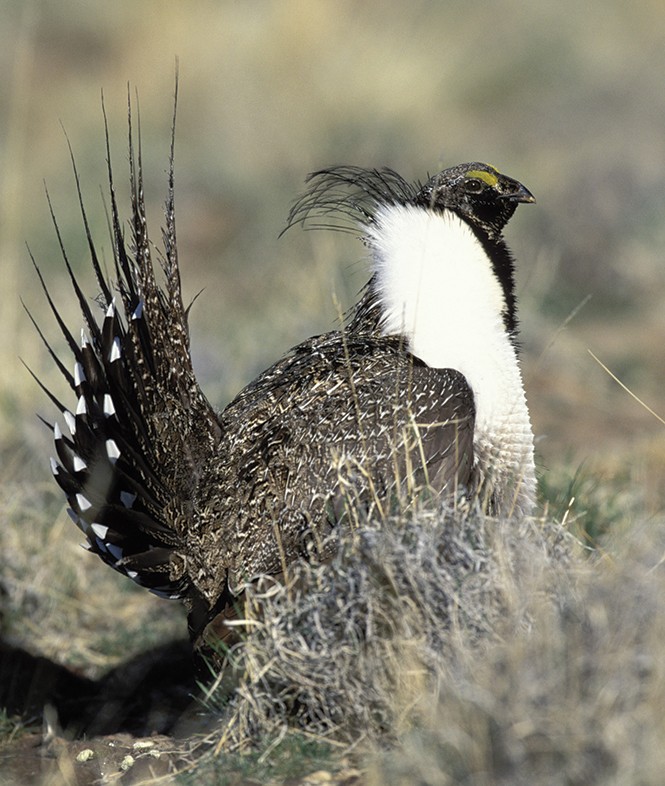Utah Rejects 'Sage' Advice
Utah leaders grouse about federal conservation plan.
By Colby Frazier @colbyfrazierlpNo conservation cause has received more gleeful fiscal support from Utah's Legislature over the past few years than protection of the sage grouse.
In the Utah House Natural Resources, Agriculture & Environment Committee, where $100,000 here and there for clean-air efforts along the Wasatch Front often crumble in the hands of unsympathetic rural lawmakers, the same group of politicians has turned around and thrown tens of millions at efforts to protect the sage grouse.
These lawmakers were united on one front: Do whatever it takes to ensure that the federal government did not scrawl the sage grouse on its endangered-species list.
In 2014, former Vernal Republican Rep. John Mathis, whose district included some prime sage grouse habitat along with a vast oil boom in the Uintah Basin, summed up his feelings this way: "This is one of the biggest issues that we face in the state of Utah: the possible listing of the sage grouse."
And so it seemed a bit incongruous when frowns appeared on the faces of Utah leaders on Sept. 22 when U.S. Department of the Interior Secretary Sally Jewell announced in a sagebrush-covered wilderness preserve in Colorado that the sage grouse did not warrant protection on the endangered-species list.
A chicken-size nesting bird, the sage grouse lives in the 173-million-acre sage-brush forests of the West. Its numbers have dwindled from 16 million to around 500,000 as subdivisions, drilling and mining—plus invasive grasslands—encroached on its habitat.
Flanking Jewell at the announcement were Republican governors Matt Mead of Wyoming, and Brian Sandoval of Nevada. Democratic governors John Hickenlooper of Colorado, and Steve Bullock of Montana, were also present.
Absent was Utah Gov. Gary Herbert, who blasted the federal government for its decision.
"I am deeply concerned with the decisions of the Department of Interior and Agriculture which constitute a significant overreach by the federal government on this issue," Herbert said in a statement. "The state of Utah has implemented a successful sage-grouse conservation plan that has been rejected by the federal government, jeopardizing conservation of the species and reasonable economic growth in Utah."
Herbert's critique was echoed by U.S. Rep. Rob Bishop, R-Utah, who said the announcement "changes nothing," and amounts to "fundamental dishonesty."
But while Herbert and Bishop fanned the flames of anti-federal government sentiment, other GOP leaders in states with vastly larger stretches of sage-grouse habitat, praised the announcement.
Herbert's contention that Utah has done a fine job protecting the sage grouse—pouring $30 million over the past five years into habitat restoration efforts—is true.
Herbert's anger over the sage-grouse decision was interpreted by some as simply more bluster and disdain directed toward the federal government, which manages the bulk of the land in the Beehive State. Utah leaders, at a cost of millions of dollars to taxpayers, are in the midst of a multi-year effort to wrest these lands from the federal government.
But Utah's successful efforts over the past five years since the federal Fish & Wildlife Service announced that the sage grouse was a candidate for being listed as endangered have taken place hand-in-hand with the federal Bureau of Land Management's efforts.
Quincy Bahr, project manager for the BLM's greater sage-grouse land-use plan in Utah, says that while the federal government manages roughly 50 percent of the sage grouse habitat in the state, it is the state that manages the wildlife.
As a result, Bahr says he's worked closely with Utah officials over the years to ensure the sage grouse was being protected, while simultaneously keeping it off the endangered species list.
"Most of the folks involved in this effort have been working closely at hand with one another," Bahr says. "In Utah, we're doing quite well."
After the announcement, as politics began to poison the information chain, Utah wildlife and habitat officials who worked on the state's sage-grouse protection plans weren't allowed to speak to the press. Instead, all questions were routed through Herbert's office.
Herbert's anger appears to be centered on the Interior Department's plan to continue to aggressively protect sage-grouse habitat while restricting human activity in sensitive habitat areas.
At the center of this plan, Bahr says, was the creation of several priority habitat-management areas, or PHMAs, which encompass roughly 3.3 million acres of federally managed land in Utah.
Where land-use restrictions were previously only in place within 1/2 mile around a sage-grouse mating area, known as a lek, land-use restrictions aimed at preventing disturbance to the surface areas are now in place across these 3.3 million acres. This will most likely make some oil drillers and developers pull their hair out.
John Harja, senior policy analyst for Utah's Public Lands Policy Coordinating office, wrote in a statement to City Weekly that the federal plans place "unduly severe restrictions on human activities and do not provide sufficient conservation value for the species to offset the hidden costs of restrictions."
Part of the reason for the expanded-protection areas, Bahr says, is the realization that the most effective way to protect the sage grouse, which has a tendency to roam, is to protect wider swathes of where it lives, not just where it reproduces.
While the new management plans will be more restrictive, it is still far less so than an endangered-species listing.
If the sage grouse had become listed, all state management efforts would have been stripped and handed over to the U.S. Fish & Wildlife Service. And, rather than seeing land-use restrictions limited to federally managed land, an endangered species listing would have put a vice-like grip on development on private, state and trust lands as well.
"The state managing those populations wouldn't have been possible had the bird been listed," Bahr says. "Being able to maintain the local control for the population is an important conclusion."
But rather than seeing the sage-grouse announcement as the culmination of fine teamwork and an invitation for continued input from Utah, Herbert saw it as a rejection of the state's efforts, calling the plan a "one-size-fits-all approach [that] does not reflect the tremendous diversity in greater sage-grouse habitats across the West."
Herbert vowed to keep trying to get the federal government to allow Utah to go it alone—a process that in the case of Medicaid expansion, has seen the state lose out on receiving hundreds of millions of tax dollars that could have returned to Zion if expansion had occured. Around 100,000 Utahns are currently denied health insurance. Herbert also threatened to sue the feds over the plan.
The more that Utah leaders bellowed their woes across its sagebrush plains, the more apparent it became that they were more-or-less alone in their tantrum.
Wyoming's Gov. Mead, whose state has far larger swathes of sage-grouse habitat than Utah, praised the Interior Department for making the "right decision."
"This is the result of Wyoming and other Western states taking a proactive approach to the greater sage grouse—working with industry, agriculture and conservation groups and the federal government," he said.
Along with the millions of dollars spent to protect sage-grouse habitat, Utah also gave $2.5 million to the lobbying firm, Stag Consulting, in an effort to convince the feds to delay the listing decision, though wildlife advocates say this lobbying was little more than a meddlesome effort to derail a solid planning effort.
Brian Rutledge, vice president of the National Audubon Society, says it's unfortunate Utah has become a lone voice of agitation in an effort to protect a bird that has habitat across 11 states.
"We really, really would like to see Utah benefit by the success, step up and be part of the community," Rutledge says. "This is the type of collaboration that [Pope Francis] was talking about [on Sept. 25] and I'm nowhere near a Catholic. The rhetoric needs to cease and the effort needs to begin."
More by Colby Frazier
-
Fire Line
UFA Board considers recouping bonuses paid to former chiefs and turning investigation over to law enforcement.
- Jan 25, 2017
-
Home Sweet Home?
How a single real estate deal highlights a city in flux and in crisis.
- Jan 4, 2017
-
Dead Red
That Utah could end up voting something other than Republican proved delusional.
- Nov 9, 2016
- More »
Latest in News
Readers also liked…
-
Raise a glass for E.L.T Harrison, architect of the Beerhive building on Main
Small Lake City
- Oct 11, 2023





